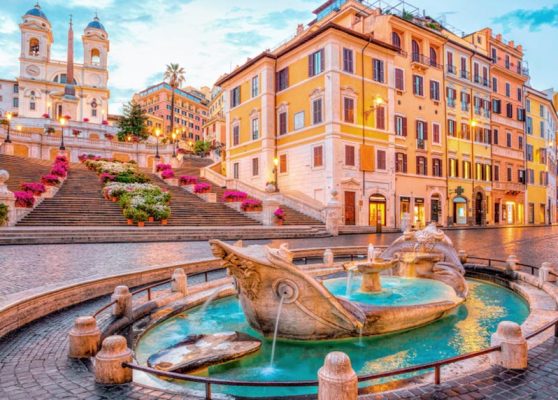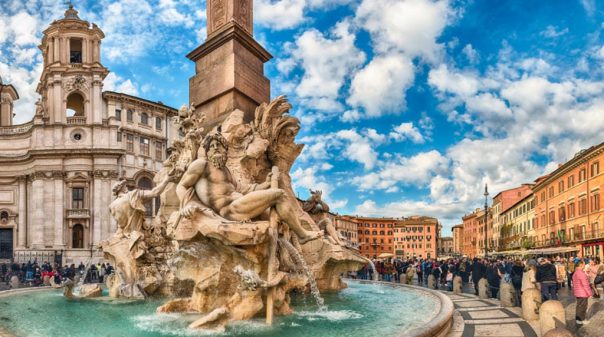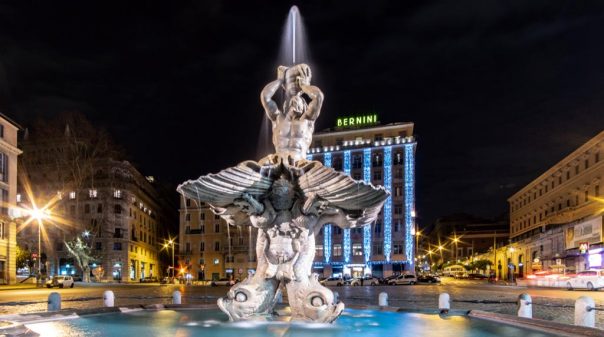What are the most beautiful fountains in Rome? From Barcaccia to the Trevi fountain, to the fountain of the four rivers.
In the photo: the “Barcaccia” built by Gian Lorenzo Bernini between 1626 and 1629. It is located at the foot of the Spanish Steps, on Piazza di Spagna.

The Romans have been passionate enthusiasts of public water since ancient times and the countless fountains present in the different districts of the city bear witness to this. The geological conformation of the land on which Rome was built gave natural outlet to countless spontaneous springs and for this reason, fountains of different sizes and artistic and cultural values still exist in almost all the urban area of the capital. Some are in fact real works of art that tell us about the painstaking work of artists and sculptors who gave birth to absolute masterpieces. The most beautiful fountains in Rome are located in the most loved and popular places every year by the many tourists in the capital, and embellish some of the most famous squares in the historic center and beyond.
The Barcaccia Fountain (in the cover photo) dominates the splendid Piazza di Spagna and is a destination for hundreds of thousands of tourists every year. It was built between 1626 and 1629 by the will of Pope Urban VIII Barberini. The architect Pietro Bernini who took care of the project wanted to create something unique and exclusive.
Built with travertine, the shape of its tank is reminiscent of that of a boat and the water seems to overflow on its sides creating the effect of sinking. The fountain has undergone several conservative interventions to ensure its integrity and the last restoration was carried out between 2013 and 2014. This fountain is undoubtedly one of the most renowned sculptural works in the city of Rome.

The Fountain of the Four Rivers, by Gian Lorenzo Bernini, fed by the Virgin Water, was inaugurated on June 12, 1651 by Innocenzo X Pamphilj (1644-1655). Imposing and majestic, it stands in the center of the square and stands out in all its beauty thanks to the Egyptian obelisk which rises and dominates the four gigantic statues that Bernini’s collaborators wanted to dedicate to four rivers representing the continents, that is the Nile , the Danube, the Rio della Plata and the Ganges.
It was built in white marble and travertine, it became a destination for walks and meditations at the end of the 15th century when the market in the square changed its location to leave room for the fountain. From the mid-17th to the late 19th century there was the custom of flooding the square by closing the drains to cool the area during the hot month of August. Today this fountain is a destination for national and international tourism and is considered a masterpiece of the Baroque era recognized all over the world.
In the center of Piazza del Popolo stands the Fountain of the Lions, built between 1814 and 1828 on a project by Giuseppe Valadier, using marble and travertine. Powered by the Virgo aqueduct, it dominates the square thanks to the presence of a large Sistine obelisk in the center and the four Egyptian-style white marble lions from whose mouth copious jets of water flow.
An important restoration was carried out in the late 90s when the whole area was made pedestrian only, and a further intervention was carried out in 2015. Suggestive especially at night when in the silence you can hear the flow of its waters in the immensity of the square, with a view of the Pincio, above, and one to the very popular via del Corso which connects the Flaminio area to the historic center.

In Piazza Barberini there is the Fontana del Tritone, a work by Gian Lorenzo Bernini, at the beginning of the 1600s. A work very different from the others created by the artist in that it does not rest on a sculptural base, but on an empty structure in the center which gives greater impetus and elegance to the whole work. Beautiful and particular, it combines a perfect technique with harmony and artistic taste.
The bees depicted on the Barberini family coat of arms, the undisputed symbol of the family, refer to the triumph of Divine Providence, while the dolphins, present at the base of the fountain, symbolically recall the benefits bestowed by the papal family. Restored during the 90s, it was subject to complete cleaning up even in 2013 when meticulous work restored the enamel and shine to the marble ruined by time, smog and limestone.
Perhaps the most famous fountain in Rome, known and appreciated all over the world, the Trevi Fountain is a must for anyone visiting the capital. In the heart of the historic center, in Piazza Trevi, this fountain is the largest and one of the most famous fountains in the city. Built on the facade of Palazzo Poli, by Nicola Salvi, a well-known architect who won a competition organized by Pope Clement XII in 1732, which was attended by many of the major artists of the time. The fountain has a large basin surrounded by sculptures and statues in the center of which the figure of Ocean dominates, driving a shell-shaped chariot.
The Trevi Fountain is internationally known for the beautiful cinematographic scene of Anita Ekberg and Marcello Mastroianni in “La Dolce Vita”, a 1960 film by Maestro Federico Fellini. Evocative and magical, it has always been a destination for those who traditionally stop in front to throw a coin and make a wish. It is said that the tourist who makes this gesture certainly returns to Rome.
The Fountain of the Goddess Roma is located in the background of the Piazza del Campidoglio and was the seat of the city municipality from the 12th century. The work, designed by Michelangelo Buonarroti (1475-1564), was built in the 16th century and was totally built in marble. The central fountain is located between the two statues of the Nile and the Tiber, and is an architectural part of the square in a more discreet and sober form than other more majestic and imposing ones present in the historic center of the city. In 1593 the statue of Minerva of the central niche was replaced with another in porphyry and marble of smaller dimensions than the original and this work takes the name of Goddess Roma.
Built in the square of the same name, designed by the architect Giacomo Della Porta, by the sculptor Leonardo Sormani at the end of the sixteenth century, it stands majestically right in front of the entrance to the Pantheon. Built with materials of great value such as travertine, Carrara marble, red granite and bronze, it is a work of absolute beauty that still recalls the glories of the past. Pope Clement XI Albani in 1711 had the imposing central obelisk added by Filippo Barigioni who created a solid sculptural base. Evocative at sunset when the city lights create magical reflections on the fountain and the Pantheon, it is a destination every year for many tourists visiting the capital.
In Piazza della Repubblica, in the Castro Pretorio district, stands the fountain of the Naiads, built with the use of granite, travertine, bronze and cement conglomerate. Its dating back to the period 1885-1914, designed by Alessandro Guerrieri, and initially located in the Termini area and later moved to the square, today it is a crossroads and an important junction between the railway station and the historic city center. Only in 1897 was the sculptural part completed by the artist Mario Rutelli who gave prestige to the monument by adding elements of great decor such as the four groups composed of nymphs, animals and water monsters, and female figures intent on playing with them under the splashing water. In 1998 it was completely restored and cleaned up and is today one of the most majestic sculptural works in the capital.
They are two twin fountains that are located in the square of the same name. Originally they were simply two basins without running water and it was in a later phase, in 1626, that the architect Girolamo Rainaldi was finally able to transform the two basins into fountains by creating seven points from which the water came out: the central gush, the two end of the Roman basin, and four other jets in the larger basin. Apart from a few details, they are practically identical and both underwent a restoration in the late 90s.
Rome fountains: the most beautiful and popular: recensioni e commenti
Hai visitato questo monumento? Cosa rappresenta per te? Quali consigli daresti ad un turista?
Dernières nouvelles du magazine